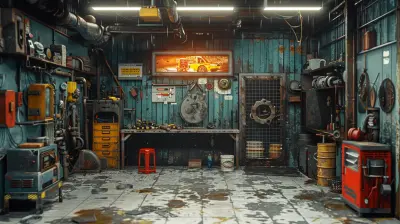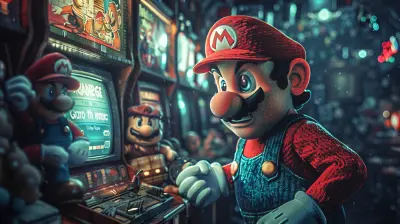How Historical Simulations are Becoming More Accurate in Games
14 September 2025
Historical simulation games have come a long way. Gone are the days when "historical accuracy" in games meant dressing characters in vaguely old-timey garb and plopping them into generic castles or battlefields. Today, developers are diving deep into the nitty-gritty details—getting everything from weapon designs to cultural nuances spot-on. And honestly? It's impressive (and a little mind-blowing) how far we've come. So, what's driving this leap in historical accuracy? Why do players care about it? And how do developers juggle authenticity with fun? Let’s break it all down.
Why Historical Accuracy Matters to Gamers
Let’s face it—no one likes a game that feels lazy or half-baked. If you’re playing a World War II game, you expect the uniforms, weapons, and even the way characters talk to reflect that era. It’s not just about aesthetics; it’s about immersion. You want to feel like you’re there, standing in the trenches or walking the streets of 15th-century Florence.But there's another layer to it. For many gamers, historical simulation titles like Assassin's Creed, Total War, or Red Dead Redemption 2 aren’t just games—they’re a way to connect with the past. Whether it's learning about significant events, experiencing cultures they’ve never studied before, or just satisfying that inner history nerd, these games let players "time travel" in a way that textbooks just... don’t.
Of course, this comes with responsibility. Gamers are quick to call out inaccuracies, especially since it's the internet age and fact-checking is just a Google search away. Whether it’s a misrepresented historical figure or an out-of-place weapon, players don’t want developers cutting corners. And honestly, who can blame them? If you’re going to build a game around history, it better respect the source material.
The Technology That’s Making Accuracy Possible
So, how are developers stepping up their game? The answer lies in technology—and wow, has it gotten powerful. Modern tools are making it easier than ever to replicate history authentically. Here’s a closer look at how:1. Photogrammetry: Building Worlds From Real Life
Ever walked through a location in a game and thought, “Wait, this looks almost real”? That’s probably photogrammetry at work. It’s a fancy term for using real-life photos to create 3D models. Developers can literally map historical buildings, landscapes, and objects, turning them into digital assets.Take games like Assassin’s Creed Unity, for example. The level of detail in Notre-Dame Cathedral is so insane that, after the real cathedral caught fire in 2019, people suggested using the game to help rebuild it. When your game’s virtual version of a historical site is that accurate, you’re doing something right.
2. AI-Powered Research
Artificial intelligence is the unsung hero of historical simulation games. Developers use AI to process massive amounts of historical data—think maps, blueprints, and written records. A good example is Paradox Interactive’s Crusader Kings III. The amount of detail the AI integrates into its political systems, historical figures, and family lineages is mind-boggling. It’s like having a personal historian baked into your game.3. Motion Capture and Voice Acting
Historical characters feel more human these days, don’t they? That’s thanks to motion-capture technology and talented voice actors. Studios are hiring actors to perform scenes as people actually would have during those eras. The result? Soldiers move like they’re weighed down by the bulky armor of the time, and villagers talk in languages or dialects that match the period.
The Role of Historians and Cultural Consultants
Sure, technology can do a lot, but it can’t do everything. That’s why game developers are increasingly working with historians, archaeologists, and cultural consultants to nail the details. These experts ensure the game doesn’t just look historically accurate but feels authentic too.For instance, in Ghost of Tsushima, the developers worked closely with Japanese historians to ensure the storyline, settings, and even samurai combat techniques were true to 13th-century Japan. Unlike earlier eras of gaming, where developers sometimes took... well, creative liberties, modern games prioritize accuracy without losing sight of the source material's richness.
Then there’s the dialogue aspect. Games set in ancient civilizations, like Assassin’s Creed Origins, go so far as to include languages like ancient Egyptian (yep, that’s a thing). The result is something that’s not just a game but a fully immersive experience—a playable history lesson.
Balancing Accuracy and Fun
Now, here’s the tricky part. No matter how much research and effort goes into making a game historically accurate, it’s still a game. And games need to be fun. Developers constantly face the challenge of balancing authenticity with engaging gameplay.After all, true history can be messy, controversial, and—dare I say it—boring at times. Nobody wants to play a game where you spend hours farming because that’s what people did in medieval Europe. So, developers take some creative liberties. Think of it this way: it’s like a historical drama. It’s based on real events but with a pinch of flair to keep you entertained.
Take Red Dead Redemption 2. Sure, it’s steeped in late-19th-century Americana, but do you really think outlaws in real life had such dramatic shootouts every other day? Probably not. But that cinematic flair is what makes the game a masterpiece.
Why This Trend Is Here to Stay
So, is historical simulation just a phase? Not a chance. For one, gamers are increasingly demanding (in the best way possible). They want smart, well-researched games that respect their intelligence and curiosity. Secondly, as technology continues to advance, the tools to create hyper-accurate simulations are only going to get better. And finally, historical games are selling like hotcakes. If the success of titles like Kingdom Come: Deliverance or Total War: Three Kingdoms tells us anything, it’s that gamers are willing to pay top dollar for a quality historical experience.Are We Headed Toward "Perfect" Historical Simulations?
Now, let’s ask the big question: will we ever reach a point where historical games are 100% accurate? Honestly, probably not. And that’s okay! No matter how advanced technology gets, there will always be gaps in our historical knowledge—and as mentioned earlier, some creative liberties are necessary to keep the gameplay enjoyable.But here’s the thing: the goal isn’t perfection. The goal is progress. And judging by how far we’ve come in just the last decade, historical simulation games have an incredibly bright future.
Closing Thoughts
Historical games aren’t just about entertainment anymore—they’re tools for exploration, education, and connection. Thanks to cutting-edge technology, talented creators, and a growing demand for authenticity, they’re shaping up to be some of the most exciting and impactful games on the market. So the next time you pick up a controller or sit at your PC to dive into one of these time-traveling epics, take a moment to appreciate the insane amount of work that went into bringing the past to life.all images in this post were generated using AI tools
Category:
Realism In GamesAuthor:

Greyson McVeigh
Discussion
rate this article
1 comments
Raine Carrillo
Finally, I can relive the Great Potato Famine in stunning detail! Just what I needed—more anxiety about my virtual harvest while I’m still figuring out how to plant a tree in Animal Crossing!
October 16, 2025 at 2:29 AM

Greyson McVeigh
I appreciate your humor! Historical simulations can be both enlightening and daunting, but they offer a unique way to learn about the past while enjoying gameplay. Happy gaming!


